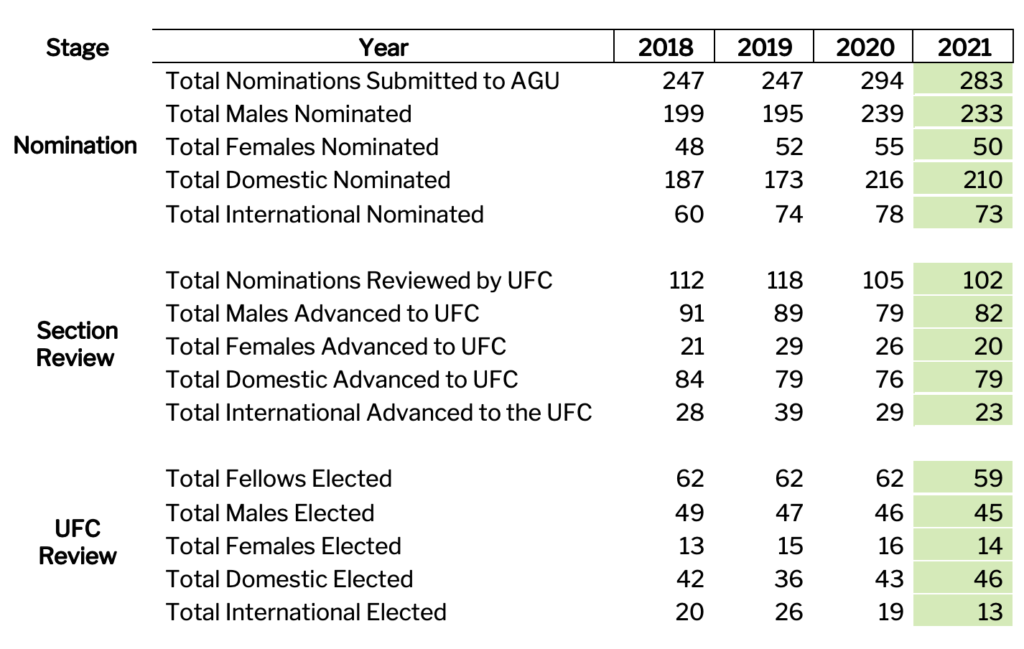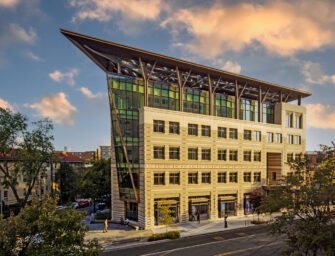2021 AGU Honors & Recognition Summary
Today, AGU President Susan Lozier and I announced the 2021 class of Fellows. These individuals are joining the prestigious ranks of the College of Fellows for their exceptional contributions to Earth and space sciences through a breakthrough, discovery or innovation in their field.
Now that the AGU Honors and Recognition Committee has announced all the recipients for 2021, we wanted to thank everyone who supported the process, including nominators, letter writers, and canvassing and selection committee volunteers.
We also have a plea for 2022: we need to remain focused and dedicated to improving the diversity of our candidate pool and recognizing excellence throughout the Earth and space science community.
Here are the details and how it compares each year since 2018:

We are disappointed that there were fewer women and fewer individuals from international countries nominated and awarded in 2021. For the first time ever, one Section chose not to advance any of their Sections’ nominees to the Union Fellows Committee for consideration. The Section felt that this was their only course of action due to a lack of diversity in the nomination pool.
We recognize that the inequities of the global pandemic may have impacted nominations, and we ask for your help in addressing these realities. The reason we made such great strides in previous years is because of every single one of you who identified and nominated someone whom you thought was deserving of AGU Honors and Recognition. We need everyone to think about their nominations earlier and to network with people who may not have the same connections or access due to systemic barriers. When we work together to uplift others, we will create the Earth and space sciences community that we want to foster and that we wished existed when we started our careers.
This is not a challenge, but a requirement for our community. It is incumbent on all of us to help ensure that the AGU honors program represents our values of integrity, respect, diversity, collaboration and education and outreach.
If we want to create a more diverse and inclusive community, every single one of us needs to actively be a part of the solution. We need canvassers and nominators to ensure they are submitting a diverse pool of candidates.
The AGU Honors and Recognition Committee is eager to work on the 2022 nomination cycle so that we can prove that 2021 was an anomaly. If there is anything we, from the committee can do to help nominators, please let us know by emailing [email protected]. We are eager for your feedback and suggestions.



[…] the Prow: 2021 AGU Honors & Recognition Summary by LaToya Myles was published Sept 28, 2021. This article summarizes the yearly changes in the […]
Here’s a fun idea that should make things considerably easier for AGU, have 50% of the fellows be men, and 50% women. I would say index it to the % of women in AGU, but that’s probably no higher than 1/3rd of the membership.
This seems harsh, but think of how it will motivate men to promote and uplift women and other underrepresented groups in the AGU community, improving the chances within their own pool of competition!
I agree that we need a more diverse nomination pool, and that the community needs to do better with our nominations. Additionally, it is a problem that AGU seems to distance itself from this process and any accompanying responsibility. Each year AGU laments the lack of progress and scolds the community instead of doing work to ensure that nominating pools are diverse next year. Have any policy changes been implemented to address this, such as requiring sections to improve Honors gender parity over time? Has AGU ever screened the initial pool for diversity and re-opened nominations when it was found to be lacking? The work of the canvassing committees (AGU and section) is mostly invisible, when we need the opposite. I only learned they exist this week despite my 15+ years of being a member. It is not clear or widely known that resources exist (do they?) to help first-time nominators assemble a compelling packet, so that we do not need to be patient for senior scientists to decide to make diverse nominations en masse.
AGU is not simply a bystander in this process, it decides the form that shapes the honors process, and it is time that it takes its share of responsibility for an outcome that it professes to dislike.
In the past few days, Paleoceanography & Paleoclimatology has been having a discussion about diversity in nomination pools. I posted the following two days ago on the PP Community webpage and was encouraged by others to post this to the broader AGU community to stimulate more discussion.
For the past year and a half, I’ve been serving as the first chair of the new AGU Canvassing Oversight Subcommittee. This subcommittee was started in 2019 to oversee canvassing activities across the AGU section canvassing committees. A primary goal is to ensure that all 25 sections have active, formal committees to work on canvassing for all AGU honors. The Subcommittee has conducted two surveys of section canvassing committee members to learn (1) how the committees conduct their canvassing; (2) what strategies and tactics have been working/not working for them; and (3) what additional resources are needed to enhance their work.
Given my brief experience as chair of the Canvassing Oversight Subcommittee, and a five-year term as either chair or member of the Macelwane Medal Committee, I was disappointed by the lack of gender balance in the nomination pool for the 2021 cycle. I read the thoughtful letter by the Cryosphere Section Fellows Committee to explain its decision not to forward any nomination packages to the Union Fellows Committee. And I read the follow-up responses by the Paleoceanography and Paleoclimatology (PP) Section officers and Fellows Committee Chair. One statement caught my attention, “Since we [PP] have been very proactive forwarding women and ethnic nominations to the Union committee over the past decade, the pool of diversity candidates with strong scientific accomplishments (as defined by AGU for Fellow consideration) has decreased tremendously.”
This progressive depletion of qualified candidates could explain the reduction in female representation in the Cryosphere nomination pool from 43% in 2016 to 6% in 2021. The Cryosphere Section has less than 1500 primary affiliation members, which theoretically should yield an actual nomination pool with adequate gender balance. But what is the demography of the section by career stage, gender, ethnicity, and nationality? Is the potential fellows nomination pool small and unbalanced demographically? Did aggressive and successful efforts to diversify the actual nomination pool lead to depletion of qualified candidates in the potential nomination pool? What are the recruitment (i.e., recovery) rates in the potential fellows nomination pool?
A progressive reduction in the diversity of actual nomination pools may be inherent to many honors and awards and begs closer scrutiny. Yet, serious attempts by professional societies to quantitatively define the depth and diversity of potential nomination pools, or monitor and model their temporal dynamics, are rare. AGU and other professional societies could benefit from a concerted effort (a hackathon?) to empirically define and model potential nomination pools and their temporal dynamics across all sections and for all awards and honors. DEI aspirations may be hard to reach until we can do this accurately and routinely.
Julio Betancourt
I have long felt that the nomination process tended to favor researchers actively working in larger universities/organizations, and neglected those working quietly alone in retirement or in small organizations, especially if the contributions are spread thin over several sections. Thus, at this year’s announcement, I tried to send an email to one of the relevant working groups with a file containing information on my contributions (not self-nomination), in hope that some one may find it fit to nominate me. I received a reply, saying that my statement had been sent to some canvassing committees. Apparently, I am judged unqualified, or my approach did not work.
Following is the information I had sent:
Having published about 100 papers, mostly first- or sole-authored, but spreading thin among different sections of AGU and retired for more than 20 years, I feel somewhat isolated and my contributions possibly overlooked. Thus, I am submitting the following information in hope that someone may see it fit to nominate me perhaps as an AGU fellow.
Education
• B. S. in Electrical Engineering, National Taiwan University, 1956
• M. S. in Electrical Engineering, Duke University, 1961
• Ph. D. in Applied Physics, Cornell University, 1965
• Research Fellow, Seismology, California Institute of Technology, 1965-66
Working Experience
• Assistant Research Geophysicist, UCLA, 1966-68
• Geophysicist and later project chief, U. S. Geological Survey, 1968-70, 73-95
• Geophysicist, National Oceanic and Atmospheric Administration, 1970-73
• Guest Researcher at University of Tokyo and International Fellow at Power Reactor and Nuclear Fuel Development Corporation of Japan, 1997-99.
Professional Activities
• AGU member since 1966
• Associate Editor for JGR, Solid Earth, early 1990s
• Organized and served as guest Editor or Co-Editor for 7 topical issues/sections, including 3 published by AGU
King, C. Y. (1980). Geochemical Measurements Pertinent to Earthquake Prediction. Journal of Geophysical Research 85(B6), 3051.
King, C. Y. (1981). A special collection of reports on earthquake prediction: Hydrological and geochemical studies. Geophysical Research Letters, 8(5), 421-424.
King, C. Y. (1984/85). Earthquake hydrology and chemistry. Pure and applied geophysics, 122(2), 141-142.
King, C. Y. (1986). Preface [to special section on Gas Geochemistry of Volcanism, Earthquakes, Resource Exploration, and Earth’s Interior]. Journal of Geophysical Research 91(B12), 12,157.
Chi-Yu King & R. Scarpa (eds) 1988. Modeling of Volcanic Processes. vi+ 209 pp. Braunschweig, Wiesbaden: Vieweg & Sohn; marketed and distributed by John Wiley & Sons. Price£ 46.00 (hardback). ISBN 3 528 08994 6. Geological Magazine, 126(4), 450-450.
Pérez, N. M., Gurrieri, S., King, C. Y., & Taran, Y. (2006, 2008). Terrestrial Fluids, Earthquakes and Volcanoes. Terrestrial Fluids.
King, C. Y., & Manga, M. (2018). Hydrological, Geochemical and Geophysical Changes Related to Earthquakes and Slow-Slip Events: Introduction. Pure and Applied Geophysics, 175(7), 2407-2409.
• Advised Chinese Institute of Seismology to initiate the journal Geodesy and Geodynamics in English and helped its early development.
Selected Publications (from about 100 papers on a relatively wide-range of topics)
1. Papers on creep events along San Andreas Fault, including one that delineated for the first time (in 1973) the kinematics of creep to be slip-propagation events, like seismic faulting, but with slip and rupture velocities 5 or more orders of magnitude smaller and magnitudes of as much as 4.7.
King, C. Y., Nason, R. D., & Tocher, D. (1973). Kinematics of fault creep. Philosophical Transactions of the Royal Society of London. Series A, Mathematical and Physical Sciences, 274(1239), 355-360.
King, C. Y., Nason, R. D., & Burford, R. O. (1977). Coseismic steps recorded on creep meters along the San Andreas Fault. Journal of Geophysical Research, 82(11), 1655-1662.
2. First paper summarizing Kinematic parameters of slow-slip events world-wide
King, C. Y. (2019). Kinematics of Slow-Slip Events. In Earthquakes-Impact, Community Vulnerability and Resilience. IntechOpen.
3. Early papers on earthquake source mechanism, including one (1967) that showed the need of using longer-period waves to define earthquake magnitude for large earthquakes.
Brune, J. N., & King, C. Y. (1967). Excitation of mantle Rayleigh waves of period 100 seconds as a function of magnitude. Bulletin of the Seismological Society of America, 57(6), 1355-1365.
King, C. Y., & Knopoff, L. (1968). Stress drop in earthquakes. Bulletin of the Seismological society of America, 58(1), 249-257.
King, C. Y. (1969). Seismic efficiency. Journal of Geophysical Research, 74(6), 1702-1703.
King, C. Y. (1970). Acoustic Efficiency of Tensile Fracture in Glass. Seismological Research Letters, 41(1), 31-36.
4. Early papers on discrimination of nuclear explosions, including a paper (1966) proposing mb vs Ms methods
Liebermann, R. C., King, C. Y., Brune, J. N., & Pomeroy, P. W. (1966). Excitation of surface waves by the underground nuclear explosion Long Shot. Journal of Geophysical Research, 71(18), 4333-4339.
Healy, J. H., King, C. Y., & O’Neill, M. E. (1971). Source parameters of the Salmon and Sterling nuclear explosions from seismic measurements. Journal of Geophysical Research, 76(14), 3344-3355.
King, C. Y., Abo‐Zena, A. M., & Murdock, J. N. (1974). Teleseismic source parameters of the LONGSHOT, MILROW, and CANNIKIN nuclear explosions. Journal of Geophysical Research, 79(5), 712-718.
5. Early papers on laboratory spring-slider faulting models
King, C. Y., & Knopoff, L. (1968). Model seismicity: Rupture parameters, stress, and energy relations. Journal of Geophysical Research, 73(4), 1399-1406.
King, C. Y. (1975). Model seismicity and faulting parameters. Bulletin of the Seismological Society of America, 65(1), 245-259.
King, C. Y. (1991). Multicycle slip distribution along a laboratory fault. Journal of Geophysical Research, 96(B9), 14,377-14,381.
King, C. Y. (1994). Earthquake mechanism and predictability shown by a laboratory fault. Pure and applied geophysics, 143(1), 457-482.
6. Paper on seismic-wave propagation
Abo-Zena, A. M., & King, C. Y. (1973). SH pulse in an elastic wedge. Bulletin of the Seismological Society of America, 63(5), 1571-1582.
7. Papers on earthquake migration
King, C. Y., & Ma, Z. (1988). Migration of historical earthquakes in California. Pure and Applied Geophysics, 127(4), 627-639.
8. Papers on spatial radon anomalies associated with active faults
King, C. Y., Zhang, W., & King, B. S. (1993). Radon anomalies on three kinds of faults in California. Pure and applied geophysics, 141(1), 111-124.
King, C. Y., King, B. S., Evans, W. C., & Zhang, W. (1996). Spatial radon anomalies on active faults in California. Applied Geochemistry, 11(4), 497-510.
9. Papers on observation of various geochemical, hydrological and geophysical changes related to or preceding earthquakes, and discussion on their possible mechanisms, including consideration of crustal heterogeneity and slow-slip events.
King, C. Y. (1978). Radon emanation on San Andreas Fault. Nature, 271(5645), 516-519.
King, C. Y. (1980). Episodic radon changes in subsurface soil gas along active faults and possible relation to earthquakes. Journal of Geophysical Research: Solid Earth, 85(B6), 3065-3078.
King, C. Y., Evans, W. C., Presser, T., & Husk, R. H. (1981). Anomalous chemical changes in well waters and possible relation to earthquakes. Geophysical Research Letters, 8(5), 425-428.
O’Neil, J. R., & King, C. Y. (1981). Variations in stable‐isotope ratios of ground waters in seismically active regions of California. Geophysical Research Letters, 8(5), 429-432.
King, C. Y. (1983). Earthquake prediction: Electromagnetic emissions before earthquakes. Nature, 301(5899), 377-377.
King, C. Y. (1986). Gas geochemistry applied to earthquake prediction: An overview. Journal of Geophysical Research: Solid Earth, 91(B12), 12269-12281.
King, C. Y. & Luo, G. (1990). Variations of electric resistivity and H2 and Rn emission of concrete blocks under increasing uniaxial compression. Pure and Applied Geophysics, 134, 45-56.
King, C. Y., Basler, D., Presser, T. S., Evens, W. C., White, L. D., & Minissale, A. (1994). In search of earthquake-related hydrologic and chemical changes along Hayward fault. Applied Geochemistry, 9, 83-91.
King, C. Y., Koizumi, N., & Kitagawa, Y. (1995). Hydrogeochemical anomalies and the 1995 Kobe earthquake. Science, 269(5220), 38-40.
King, C. Y., Zhang, W., & Zhang, Z. (2006). Earthquake-induced groundwater and gas changes. Pure and Applied Geophysics, 163(4), 633-645.
King, C. Y., & Chia, Y. (2018). Anomalous Streamflow and Groundwater-Level Changes before the 1999 M7. 6 Chi–Chi Earthquake in Taiwan: Possible Mechanisms. Pure and Applied Geophysics, 175(7), 2435-2444.
10. Papers showing the characteristics of water wells that are sensitive to earthquake occurrence, and identifying local permeability changes induced by slow-slip events as the cause of the observed pre-earthquake water-level changes.
King, C. Y., Azuma, S., Igarashi, G., Ohno, M., Saito, H., & Wakita, H. (1999). Earthquake‐related water‐level changes at 16 closely clustered wells in Tono, central Japan. Journal of Geophysical Research: Solid Earth, 104(B6), 13073-13082.
King, C. Y., Azuma, S., Ohno, M., Asai, Y., He, P., Kitagawa, Y., Igarashi, G. & Wakita, H. (2000). In search of earthquake precursors in the water-level data of 16 closely clustered wells at Tono, Japan. Geophysical Journal International, 143, 469-477.
King, C. Y., Zhang, W., & Zhang, Z. (2006). Earthquake-induced groundwater and gas changes. Pure and Applied Geophysics, 163(4), 633-645.
King, C. Y. (2018). Characteristics of a sensitive well showing pre-earthquake water-level changes. Pure and Applied Geophysics, 175(7), 2411-2424.
11. Paper on the volume predictability of volcanoes
King, C. Y. (1989). Volume predictability of historical eruptions at Kilauea and Mauna Loa volcanoes. Journal of Volcanology and Geothermal research, 38, 281-285.
12. Papers on fracture mechanics and the effect of thermal stress in meteoroids
King, C. Y., & Webb, W. W. (1971). Internal fracture of glass under triaxial tension induced by thermal shock. Journal of Applied Physics, 42(6), 2386-2395.
King, C. Y. (2003). Thermal stress in meteoroids by aerodynamic heating. Crustal Deformation and Earthquake (a Chinese journal).
https://earthdata.nasa.gov/learn/pathfinders/disasters